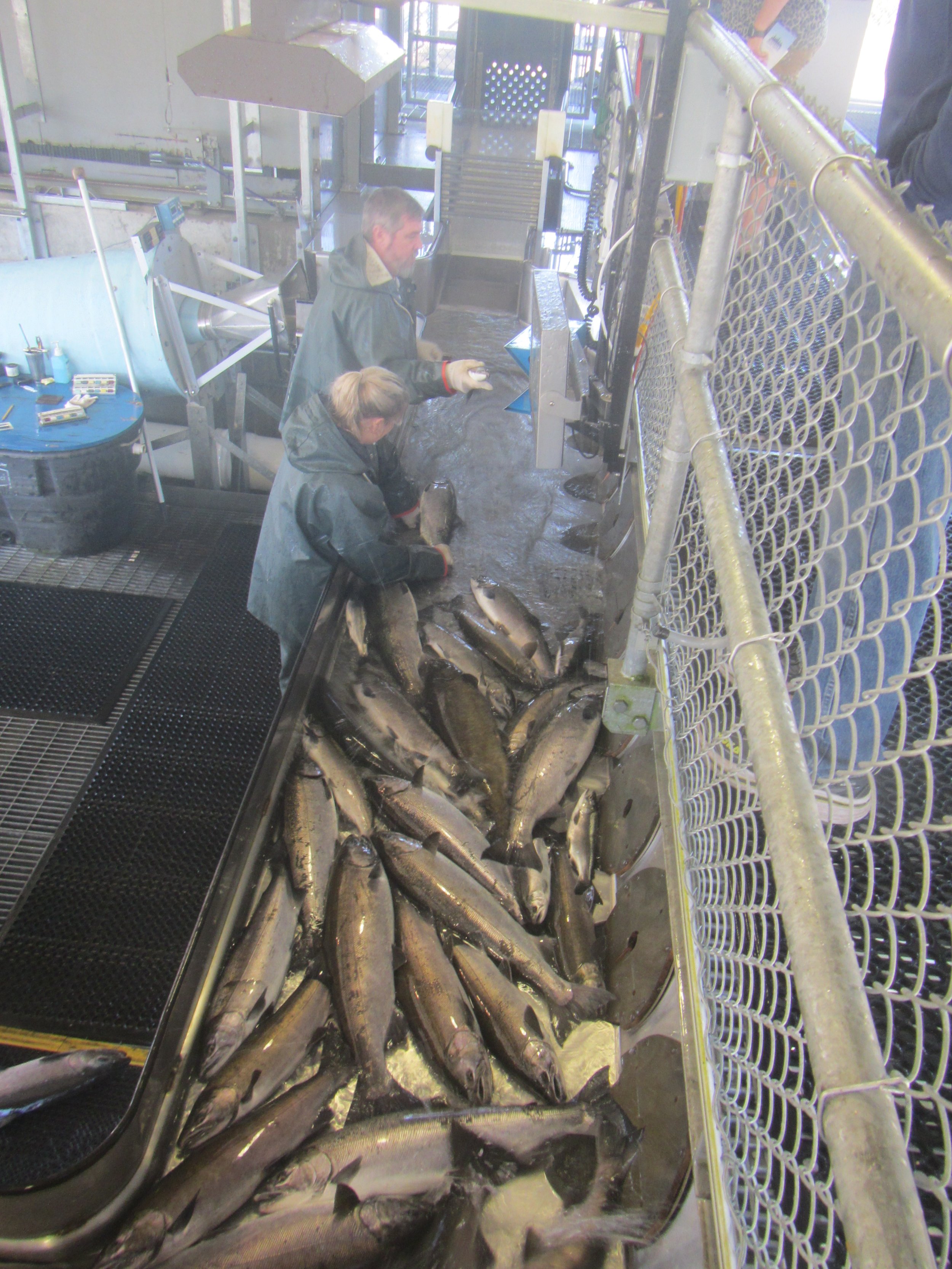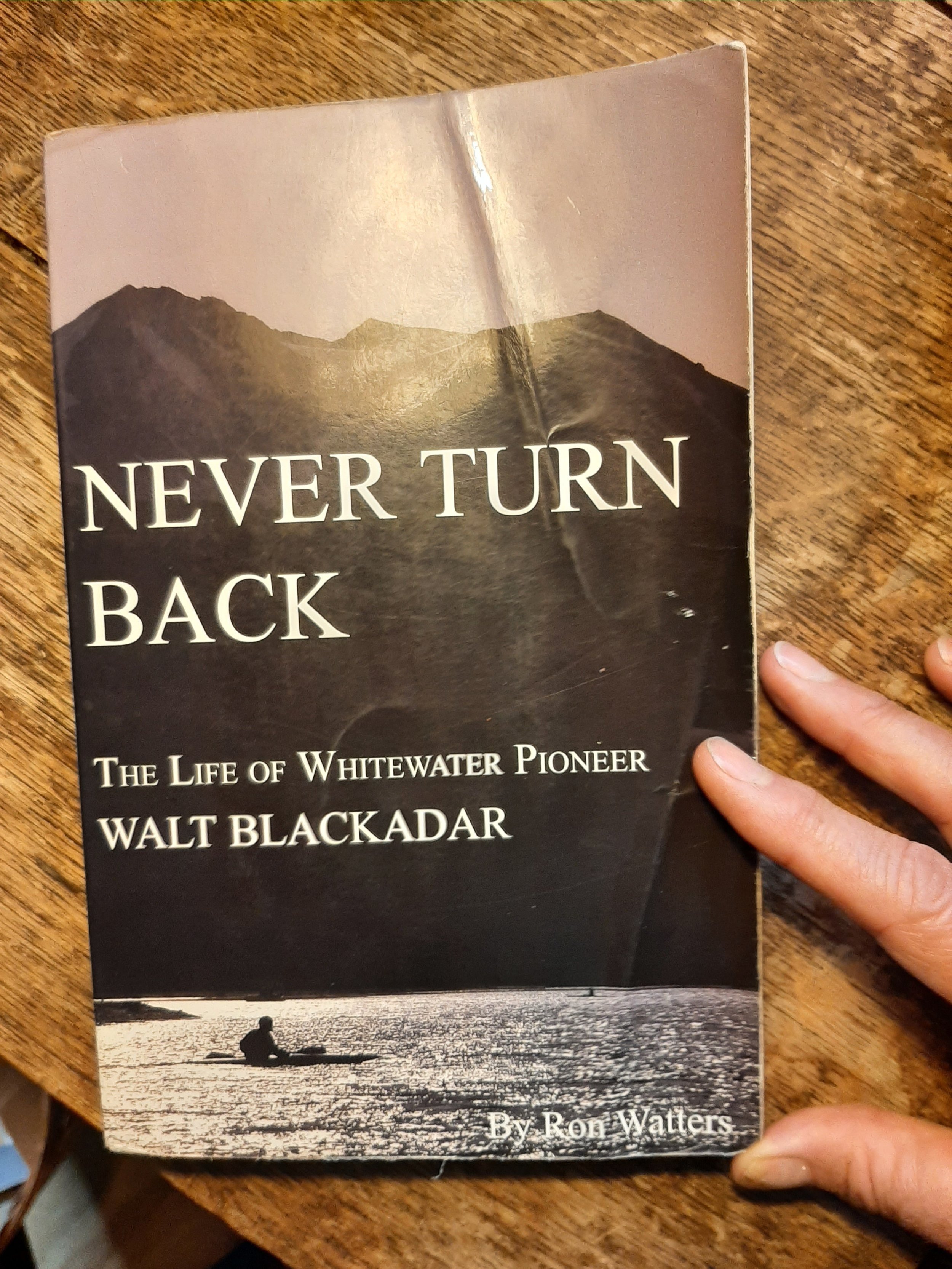Where did the salmon go?
By Teresa Gryder
Hidden Mindy, Crouching Salmon. A cascade and swimming hole in the Cowlitz drainage, by Daniel Johnson.
I call this place Whitewater Heaven and during rainy season that is 100% true. But it would be 200% true if the salmon ran like they used to. City people may not know what has been lost. The number of salmon migrating through the Lower Columbia is a tiny fraction of what it was a century ago. Salmon were the main food source for countless tribes from here to Idaho, and the basis for a huge industry for the white man when he arrived. Now the white man's salmon industry is commercial fishing out in the ocean.
In the summertime the rivers of the Portland-VanCouver area gradually dry up. First the rainfed runs, like the Wilson, stop flowing. Then the snow melts and we paddle the Hood and Sandy which descend from Mount Hood, and all the big rivers of central Idaho. By the end of the summer the snowmelt is gone and we are left with just a few springfed runs, like the White Salmon and the Metolius.
Places where there used to be glaciers now have just snowpacks. Where there used to be snowpacks, snow is disappearing completely. Where rivers used to run cold on late summer snowmelt, the water is warm. After a very wet '22-'23 winter, Washington had to declare a drought, again. The Department of Ecology says "Even without the warming of earth’s atmosphere, drought conditions can be expected to recur every few years. But temperatures are rising and summers are getting drier. Snowpack, a major source of Washington’s water supply, is declining. Low snowpack years will become more frequent in the future."
Oregon is no better off. Even our springfed rivers are getting lower than they ever used to. Some say it's because there are more people pumping out groundwater from the flanks of our snowtopped volcanoes. Maybe it's the drought. The change is big, and complicated.
Oregon drought levels as of 8/3/23.
Some have made dire predictions about the demise of whitewater boating as recreation because so many rivers are getting less runnable, lower flows, more obstructions. As hard as AW and ACA work on dam removals, there are those who are eager to impound any water that runs free.
Large multipurpose dams have clogged the lower Columbia and Snake rivers. Bonneville Dam was the first, built in 1938. The Dalles dam was built in 1957, and the John Day dam was built in 1971. The Snake River dams were approved by congress in spite of resistance, and built between 1957 and 1975.
Biologists back then were not so shy about saying that the dams were the reason for decimated salmon runs. Even federal fishery agencies were against the building of Ice Harbor Dam, which was the first in the lower Snake series to be built. Dams on the Snake made Lewiston, Idaho into a port for grain transport. Barge is the most efficient way to transport large loads, and the farmers liked the idea of reduced transport costs. They didn’t realize that the dams wouldn’t, in the end, support healthy economic growth in the region.
Salmon can't survive warm water. They are programmed to spawn (swim upstream to lay eggs) by sniffing out familiar fresh cold water and following that upstream. Somehow, a few of them make it all the way to Idaho, still, through fish ladders and reservoirs. Then they have to survive going back downstream through warm reservoirs full of "trash fish" for whom smolts are food.
Sorting salmon in a hatchery on the Cowlitz. Photo by TG.
A lot of young fish are introduced by hatcheries, raising questions about the genetic diversity of the surviving populations. Hatchery fish have been shown to outcompete wild fish. For all the money (About $1B/year in the PNW) spent on salmon restoration, we have little to show for it, because we haven't addressed (can't address?) the largest causes of decline. Removing dams will help, but then there will be other limiting factors. Patagonia has a video about why we should remove the Lower Snake Dams.
People want to believe that we can fix the salmon situation by adding logs to streams and making more spawning habitat, especially in streams lower in the Columbia drainage. I understand the desire, and the deeply human need to remain optimistic. I'm told that salmon are amazingly resilient.
Among the rivers that we run, there is an effort to enhance habitat on the Coweeman in Washington, which is below all the dams on the Columbia and Snake. The Coweeman is a small river that flows to the west, one ridge south of the Toutle. Its headwaters do not reach the high ground of Mount Saint Helens, so it does not have snowmelt flowing through it late in the summer, but the water remains cool. We run it primarily during the heaviest of winter storms, and are always on guard for the log jams which naturally form.
Coby runs left of a Coweeman log jam (below Cable rapid) in 2015. Photo by TG.
Will and I are both studying on the question of how to bring salmon back. The more I learn, the less hope that I have. Salmon require not just spawning grounds, but also places for the young smolts to grow, ways to travel up and down the rivers where they spawn, and an ocean environment that allows them to mature. Development along our coasts and lowlands has narrowed river channels and eliminated a lot of the places where the smolts used to hang out, feed and grow. Commercial fishing in the ocean takes a huge chunk out of the mature populations that might someday spawn. The ocean is warming and acidifying, snowpacks on the mountains are shrinking, the times, they are a'changing.
The current rush to install logs in rivers is based on a huge amount of federal funding that is directed at helping salmon. Installing logs is easy to do, and there are lots of businesses offering just that service and positioning themselves to pad their pockets from federal grants coming out of the infrastructure bill.
Allowing all the federal funding to go down this salmon-helping avenue will clog a great many sections of river that ecologists call "transport reaches" because logs usually move through them. Log jams form, then break up, naturally. Transport reaches are the ones with good whitewater. What we are looking at is massive federal funding that is likely to eliminate our "playgrounds" ostensibly to help the salmon. There has not been sufficient "limiting factor analysis" to really show what will help them the most.
One "transport reach" that is currently clean but might soon have logs installed by helicopter is Copeland Creek, a tributary of the North Umpqua. This is a class 3-4 rainy season run that I would like to explore this winter, before it is too late.
A lack of spawning habitat may not be the limiting factor in Copeland Creek or the Coweeman. Salmon also need smolt-rearing habitat, cold rivers to swim up and back down to the ocean, and a survivable ocean. We must think bigger and address more of the limiting factors for the salmon if we are to make any difference at all.
We just finished reading Never Turn Back: The Life of Whitewater Pioneer Walt Blackadar, by Ron Watters. It was published in 1994, and tells the tale of a young MD who moved to Salmon, Idaho in 1949. He was a conservative who wanted nothing more than to live where there was good hunting and fishing. He ended up becoming a liberal activist, working to protect his hunting grounds and fishing streams from the timber industry and other development. He was part of the movement that secured the Frank Church Wilderness, the largest wilderness in the lower 48.
Book: Never Turn Back, The Life of Whitewater Pioneer Walt Blackadar, by Ron Watters.
It was from Never Turn Back that I learned that the South Fork Salmon (a favorite multiday run) used to have some of the biggest salmon runs ever seen anywhere. The salmon there were devastated by logging, first. Years of clearcutting followed by a heavy rain year caused massive landslides and heavy sedimentation of the riverbed. The pools where salmon had laid their eggs were filled with mountains of rock and gravel. Then the big dams were built on the Snake and Columbia, putting another nail in their coffin. The South Fork Salmon has cleaned itself, but the salmon runs there are nothing like what they were until the 1960's.
Never Turn Back tells the tale of how Blackadar discovered and learned whitewater kayaking, how he survived Turnback Canyon of the Alsek, explored a great many western rivers, and met his demise in the South Fork Payette canyon. It's a book worth reading, but it's out of print. The paperback costs $40 and I have to return this borrowed copy to its rightful owner. If you are as interested in our rivers as I am, I recommend you locate a copy.
If you are also interested in salmon recovery, now is the time to start asking questions and getting involved in salmon restoration efforts. It might be better if you don't advertise that you are a boater, because our recreation is denigrated as low-importance relative to the fish. We need all hands on deck to keep the current burst of funding from causing hasty and ill-advised salmon restoration efforts from clogging all our fast rivers.
Thanks to Thomas O'Keefe and Steve Rentmeester for their perspectives and information about salmon ecology, history, and politics. Thanks to Carter Wray for the book loan.




